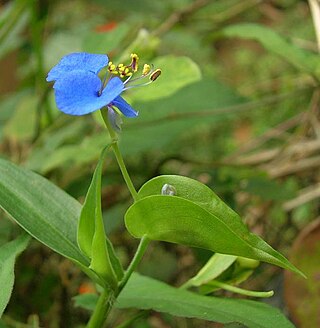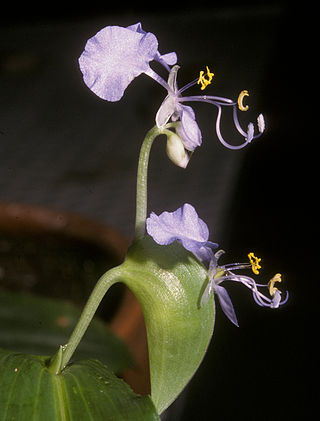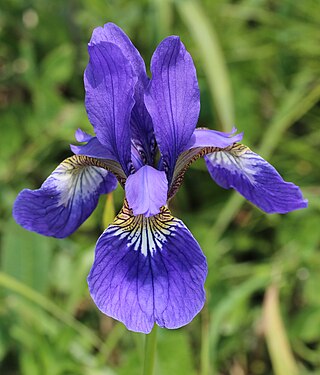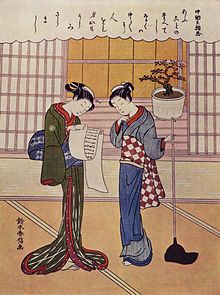
The stamen is the pollen-producing reproductive organ of a flower. Collectively the stamens form the androecium.

In botany, a bract is a modified or specialized leaf, especially one associated with a reproductive structure such as a flower, inflorescence axis or cone scale. Bracts are usually different from foliage leaves. They may be smaller, larger, or of a different color, shape, or texture. Typically, they also look different from the parts of the flower, such as the petals or sepals. A plant having bracts is referred to as bracteate or bracteolate, while one that lacks them is referred to as ebracteate and ebracteolate, without bracts.

Commelina is a genus of approximately 170 species commonly called dayflowers due to the short lives of their flowers. They are less often known as widow's tears. It is by far the largest genus of its family, Commelinaceae. The Swedish taxonomist Carl Linnaeus of the 18th century named the genus after the two Dutch botanists Jan Commelijn and his nephew Caspar, each representing one of the showy petals of Commelina communis.

Commelinaceae is a family of flowering plants. In less formal contexts, the group is referred to as the dayflower family or spiderwort family. It is one of five families in the order Commelinales and by far the largest of these with about 731 known species in 41 genera. Well known genera include Commelina (dayflowers) and Tradescantia (spiderworts). The family is diverse in both the Old World tropics and the New World tropics, with some genera present in both. The variation in morphology, especially that of the flower and inflorescence, is considered to be exceptionally high amongst the angiosperms.

Cornus canadensis is a species of flowering plant in the dogwood family Cornaceae, native to eastern Asia and North America. Common names include Canadian dwarf cornel, Canadian bunchberry, quatre-temps, crackerberry, and creeping dogwood. Unlike its relatives, which are for the most part substantial trees and shrubs, C. canadensis is a creeping, rhizomatous perennial growing to about 20 centimetres tall.

Dicentra cucullaria, Dutchman's britches, or Dutchman's breeches, is a perennial herbaceous plant, native to rich woods of eastern North America, with a disjunct population in the Columbia Basin.

Commelina tuberosa is an herbaceous perennial plant in the dayflower family which is native to Mexico but grown worldwide as an ornamental plant. It is characterized by its purple-splotched spathes with free margins, its bright blue petals of equal size, its tuberous roots, and its four to ten flowered lower cymes. In the wild, it is encountered in moist fields, open forests, or pine-oak forests. The species is sometimes considered to include the species Commelina coelestis, Commelina dianthifolia, and Commelina elliptica, such as in the Flora Mesoamericana. When these are treated as separate, they are often referred to as the "Commelina tuberosa complex". Horticulturally, the species are often treated as separate entities because of their differing habits and leaf shapes. In this sense, Commelina tuberosa is a low-growing plant with long narrow leaves.

Commelina diffusa, sometimes known as the climbing dayflower or spreading dayflower, is a pantropical herbaceous plant in the dayflower family. It has been introduced to the southeastern United States where it is most common in wet disturbed soils. There are two recognised varieties, one being the type and the other being C. diffusa var. gigas, which is native to Asia and has been introduced to Florida. It flowers from spring to fall and is most common in disturbed situations, moist places and forests. In China the plant is used medicinally as a febrifuge and a diuretic. A blue dye is also extracted from the flower for paints. In the Hawaiian Islands, it is known as "honohono grass", although it is technically not a grass. "Honohono" refers to the alternating structure of the leaves. At least one publication lists it as an edible plant in New Guinea.

Commelina caroliniana, sometimes known as the Carolina dayflower, is an herbaceous plant in the dayflower family native to India and Bangladesh. Both the scientific name and the common name are misleading as the plant was described based on specimens found in the southeastern United States before it was known that the plant had in fact been introduced from India. It was most likely introduced to South Carolina in the late 17th century along with rice seed from India. The plant has also been recently reported from South Korea. Its flowers emerge from summer to fall and rarely into the winter.

Commelina benghalensis, commonly known as the Benghal dayflower, tropical spiderwort, or wandering Jew, kanshira in Bengali, is a perennial herb native to tropical Asia and Africa. It has been widely introduced to areas outside its native range, including to the neotropics, Hawaii, the West Indies and to both coasts of North America. It has a long flowering period, from spring to fall in subtropical areas, and throughout the year closer to the equator. It is often associated with disturbed soils.

Commelina cyanea, commonly known as scurvy weed, is a perennial prostrate herb of the family Commelinaceae native to moist forests and woodlands of eastern Australia, Lord Howe Island and Norfolk Island. The blue flowers appear over the warmer months and are pollinated by bees and flies.

Commelina lukei is a monocotyledonous, herbaceous plant in the dayflower family from East Africa. This blue-flowered herb has been recorded in lowland areas of Kenya, Tanzania, and Madagascar, where it is found in a variety of habitats ranging from forests to grasslands to roadsides. Described in 2008, the species was previously confused with Commelina mascarenica and Commelina imberbis. Despite this misinterpretation, a third similar species, Commelina kotschyi, is actually most closely related to C. lukei. The plant's distinctive features include a scrambling habit, capsules with a rounded extension at the apex, appendaged seeds, clasping leaf bases throughout, and solely needle-like hairs along the upper side of the leaf's midrib. The species was named in honour of the botanist W. Q. R. Luke, whose collection of the plant served as the type specimen and allowed for a complete illustration and description.
Commelina sphaerorrhizoma is a monocotyledonous, herbaceous plant in the dayflower family from south-central Africa. This blue-flowered herb has been recorded from western Zambia, central Angola, and the southern portion of the Democratic Republic of the Congo, although at the time of its description it was known only from 11 collections and may be more broadly distributed. It is found in a variety of habitats ranging from woodlands to grasslands to roadsides. The plant's most distinctive feature and the source of its scientific name is its moniliform rhizome composed of spherical segments that can form a bead-like chain. Other distinguishing characteristics include glaucous leaves with clasping bases, unfused and virtually hairless spathes, capsules composed of three, one-seeded locules, and very large seeds with a hairy surface.
Commelina grossa is an herbaceous plant in the dayflower family found in the East and Southern African countries of Tanzania, Malawi, and Zambia. The species is easily recognised by its mainly basal leaves which are long and linear, and its spathes, which lack hairs and are quite large. The petals are mauve-blue with the lower petal being highly reduced and the sepals fused into a cup. These features suggest it may be related to Commelina schweinfurthii and its allies, which share many of the same floral characters. The species' typical habitat is in woodland on sandy soil or soils that become seasonally waterlogged. Flowering occurs in April and June.
Commelina acutispatha is an herbaceous plant in the dayflower family found primarily in East and Central Africa, including limited distribution in the African Great Lakes country of Uganda. In addition to that country, it is known from Sierra Leone, Liberia, Ghana, Togo, Nigeria, Cameroon, Gabon, and the Democratic Republic of the Congo. It is a common species in regions of West Africa with significant forest cover, where it is often weedy. It is most common in disturbed, moist soils, in which it scrambles over other plants. The name Commelina thomasii was often used for West African plants until it was realized that Commelina acutispatha, an older name originally applied to plants from the Democratic Republic of the Congo, was the same species. The petals range in color from white to pale lilac to violet; the lower petal is about half as large as the upper paired petals. The central anther is reported to have a blue patch on the connective. It has solitary spathes borne on a peduncle covered in hook-hairs.

Commelina fluviatilis is an herbaceous plant in the dayflower family found primarily in Central Africa. It is known from Tanzania, the Democratic Republic of the Congo, Zambia, and the Caprivi Strip region of Namibia.

Commelina maculata is an herbaceous plant in the dayflower family found in India, Burma, Bhutan, and southern China. It is most often encountered along forest margins, in grasslands, along roadsides, or in moist ditches. The species is characterized by its short-stalked spathes with fused margins that usually occur in clusters of two or three, bearing flowers that barely stick out from the mouth of the spathe. The species is very similar to Commelina paludosa, and further study is needed to recognize the boundary between the two. The two are typically differentiated on the basis of C. paludosa having larger and more numerous spathes that occur in clusters of four to ten, forming a sort of head. C. paludosa is also reported to have larger leaves, a more erect habit, less branching, and thicker stems. On the other hand, C. maculata is supposed to have heads of only two to three spathes, low-growing stems, numerous branches, slender stems that root at the nodes, and leaves less than ten cm long by two and a half cm wide.
Commelina hockii is an herbaceous plant in the dayflower family found primarily in Central Africa, from southwestern Tanzania in the east, west through the Democratic Republic of the Congo and Zambia, and possibly extending further west to Angola. The species' distinctive features include its long, tapering spathes with unfused margins, its white flowers, and its many-flowered lower cymes. It can be found in grasslands and Brachystegia-dominated woodland. It is fairly unusual among Commelina species in having variation in the color of the antherodes, with some individuals having entirely yellow antherodes, while others contain a dark spot in the center. Also, it is one of the only Commelina species known to leave a papery residue of dried fluid inside its spathes; normally only fused-spathe species are known to produce this substance. Only one specimen from Angola resembles this species, but it has blue flowers, suggesting it may be a poorly understood and as-yet undescribed separate species. Commelina hockii is probably closely related to Commelina kituloensis, which shares a similar fruit type, the same tufted perennial habit, similar large spathes with dried fluid substance, and equally numerously flowered inflorescences. That species differs in having purplish flowers, hairy leaves, shorter spathes, and a preference for high altitude grassland.

Iris sanguinea is a rhizomatous flowering plant in the genus Iris and in the series Sibiricae. It is cultivated as an ornamental plant in temperate regions. It is one of the species considered a Japanese iris. It is from Asia, found between Russia, Mongolia, China, Japan and Korea. It has grey green leaves, an unbranched flowering stem and flowers in reddish-purple shades, from blue to blue-purple, red-violet, with a rare white variant.

Cyanothamnus subsessilis is a species of plant in the citrus family, Rutaceae and is endemic to the south-west of Western Australia. It is a woody, mostly glabrous shrub with simple leaves and flowers with four petals that are white on the front and green to blue on the back.






















